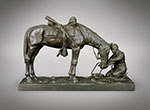
- ESTABLISHED 1976 -
Schreyvogel
Charles
Charles Schreyvogel was born in New York City in 1861 the son of migrant Germans bound and determined to make America their new home following departure from a tumultuous Europe and, specifically, Germany. His father, Paul, and mother Teresa Erbe Schreyvogel were shopkeepers in New York’s Lower East Side. Charles was the second of three sons born in the family and from his early years in the public schools he surprised his teachers with delightful sketches. These were the predecessors to his fervent desire to become an artist, an avocation that his prosperous, merchant father found little favor with. He was not to denied and early exposure to August Schwabe, a dedicated fan of the arts and struggling artists, and later to Dr. William Redwood Fisher, led to study in Europe at the Munich Art Academy with Karl von Marr and Frank Kirchback.
Charles Schreyvogel eventually became one of the most popular artists ever to depict the American West in paint and bronze. His early life of struggle with poverty and health led to an ever-present desire to excel. His first national recognition came from a first prize in the 1900 National Academy Exhibition with his entry, My Bunkie. Numerous works were reproduced as lithographs, gravures and platinum prints. The Duel is one such work to have been reproduced.
His extensive forays to the west resulted in field sketches that were used in his Hoboken, New Jersey studio to depict some of the most popular renditions of American cavalry officers and their Indian adversaries. His highly publicized debate with the very popular, and jealous, artist, Frederic Remington, over the authenticity of the ingredients and the scene depicted in his painting, Custer’s Demand resulted in an outpouring of support from relatives and friends of Custer: his widow, Elizabeth, President Theodore Roosevelt and Col. J. S. Crosby, himself depicted in the work. His place in history was firmly established by his expertise and talent.
His works are scarce and sought after. Fewer than one hundred paintings are known to have been recorded due to his limited output and short life span. His works are held sparingly by major museums and collections worldwide.
(1861 - 1912)
Back to Inventory



